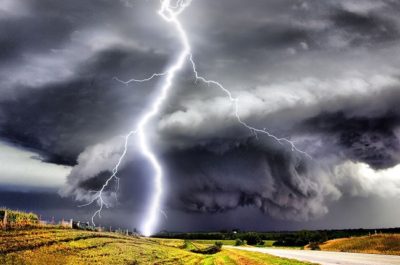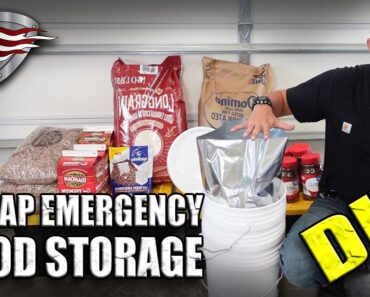The spring storm season is here, and for thousands of people in the United States, that means time to start preparing the homestead. It is important to becoming mentally aware of how to react should you find yourself in the midst of a natural disaster.
Summer and fall seasons bring a number of different types of storms, ranging from hurricanes and tornadoes to floods and wildfires. Being aware of the types of disasters your area is most prone to is important when preparing your home, and understanding your surroundings is key to being prepared. Ask yourself if you live in a mudslide or easily flooded area, and know what you and your family will do in case of an emergency. While forest fires can spread to nearly every region as quickly as the winds change, certain places know that they are more vulnerable to tornadoes, floods or hurricanes. Early preparation for your family and homestead is important when you only have a moment’s notice, so here are some tips to keep you as safe and secure as possible when natural disasters strike.
Equipment
While most people living the homestead lifestyle are probably already aware of the need for backup power, making sure that you have everything you need is another story. If you have solar generators as a backup, do you know how to use them in a power outage? If you use gas generators, do you have enough gas stockpiled? Combustibles should always be stored in appropriate containers and locked away from your home and children. Also, ensure you know where your fire extinguishers are and check yearly to see if they are filled and working properly. Extra batteries, flashlights, rope, duct tape, a crowbar, and a charged phone should always be part of your evacuation kits as well.
Spring Storm Home Readiness
Since there are so many different types of natural disasters, being prepared for anything can be a difficult task. It is wise to consider that when one disaster strikes, other consequences can follow. For this reason, start from the bottom and work up to ensure that every part of your home is covered. Pick things off of the floor in your basement or flood-prone areas, and elevate machinery such as washers and dryers onto a platform that is high enough to escape rising water levels. In the main part of your house, evaluate heavy and loosely secured items on the walls and ceilings, in case there is flying debris. Also, be sure to separate any chemicals that may mix together and cause toxic fumes in the event of earthquakes or storms.
Story continues below the video
Secure your roof by checking yearly for loose shingles, and consider purchasing metal connectors to attach trusses and beams that will prevent roof lift during high winds. Hurricane clips, straps and ties can be purchased at your local hardware store to connect studs from your home to your roof, securing the structural integrity as best as is possible. Check outside your home for any low-hanging branches or trees that appear ready to die or fall over. In the case of flooding, the ground becomes soft, and large trees will easily uproot and fall, causing major damage to your property. If a tree is leaning toward your home, it is a good idea to consider having it removed. Also, bring in or secure any patio furniture, toys or loose items that are outside to keep them from blowing around and flying into your home.
Pocket sized device provides emergency backup power.
Make sure everyone in your family is aware of where the shut-off is for your utilities, such as power, gas and water, and also that each individual understands how to manually work the valves and switches. Keeping fresh, potable water stored in a safe and accessible location on your property is also something to consider in case of pump and electrical failure. If you haven’t built a shelter, take some time to look around your home and decide where the most structurally secure walls and roof beams exist, and make sure that this area is clear of any obstacles or potentially hazardous items that may shift during a natural disaster. If you have fair warning of impending disaster, always cover your windows with boards or storm shutters to keep flying objects from coming into your home.
Story continues below the video
Kits/Personal Item Bags
During spring storm season, whether it be wildfires or tornadoes, keeping a bag of personal items and family treasures, such as priceless pictures and heirlooms, in a secure location that is easily accessible to move quickly will save the devastation of losing those belongings should anything happen to your home. (A modern alternative: Scan them and store them in the “cloud.”) A bag with emergency clothing and a first-aid kit should be prepared to grab and dash out of the house as well. Make sure to keep important information like your insurance policies and important phone numbers written down and not just saved in your phone, and keep time and date stamped pictures of your valuables for insurance purposes. Know your evacuation routes and keep an update on where local emergency shelters are in your area.
It is also a good idea to keep emergency items in your car for a quick exit, such as a first-aid kit, jumper cables, a spare tire, blankets, canned items, and clothes. In a camping kit, make sure to have pots and pans, utensils, matches or lighters, aluminum foil, and a can opener for food. Emergency camping blankets that shield from high heat and freezing temperatures can also be a lifesaver if you are caught outdoors, in your car, or in a situation where help may be delayed for an extended period of time. Store these items in a bag in your shelter, and make sure that you have easy access to them should you need to evacuate to your car quickly.
Dependable And Affordable Backup Power You Can Trust
Natural disasters can strike in a moment’s notice, so constantly being prepared and keeping your family informed of proper evacuation and safety procedures is the number one step to staying alive. Get underground or to a secure location in the event of tornadoes, evacuate flood-prone areas during hurricanes, never drive your car through flood water, and when water levels rise, always seek high, secure ground that isn’t prone to landslides.
Remember that winds shift quickly during fires, and water levels can rise in a moment’s notice during floods, so don’t wait until the last minute to decide what is best for your family. Homes can be repaired, but your family cannot be replaced. Always be aware of your surroundings and check for downed power lines, sinkholes, open sewage lines, or other potentially hazardous situations before approaching disaster areas. Being prepared for the impending storm season is the best way to keep yourself and your family safe and protected the whole year.
For more information and complete kit checklists, visit www.ready.gov/natural-disasters
What would you add to this list? Share your suggestions in the comments section below:



























